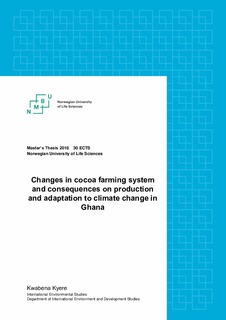| dc.description.abstract | In the quest to restore her position as the leader in global cocoa production, the Government of Ghana has made several reforms and interventions in the cocoa farming system, in the areas of institution, marketing, social and agronomic. This study attempts to identify how these changes in the cocoa farming system have contributed to production yield and adaptation to climate change. With the help of multi-stage cluster and simple random sampling techniques, a sample size of seventy-eight smallholder cocoa farmers from seven farming communities within Nsuta Zone in the Techiman Municipality were selected and interviewed through a well-structured questionnaire. The data collected was analysed with Statistical Package for Social Sciences (SPSS) and Microsoft Excel. Descriptive statistics tools were used for the data analysis. The study revealed that shared-crop project scheme (abunu) system is the major mode of land acquisition for cocoa farming, which has adverse effects on farm size and cocoa output. The increase of producer price of cocoa to 70% (fob) price as a major market reform has contributed to increase in farmers income, which has made it possible for the farmers to purchase inputs to enhance production and adaptation to climate change. The study also revealed that there has not been much improvement in infrastructure and provision of social amenities in the rural areas and this have had negative impact on cocoa production. 90% of the farmers benefited from the cocoa mass spray and fertilizer subsidy programmes. 87.2% of the farmers who benefitted from these programmes indicated increases in their farm yields. The adoption rate of hybrid cocoa seeds as an adaptation measure was 58%. The study also revealed that the vulnerability level of the farmers, especially those with smaller farm sizes was very high due to low investment in good agronomic practices and adaptation measures resulting from lower incomes. Other factors that made cocoa farmers in the study area more vulnerable to the climate change impacts are low level of education, lack of adequate information on climate change adaptation measures and large family sizes. The major long-term adaptation strategies adopted by the farmers included planting of economic shade trees, diversify income sources and irrigation. The study concluded by suggesting that the government must improve infrastructure in the rural areas to retain youths to increase productivity, ensure 100% coverage of cocoa mass spray and fertilizer subsidy programmes, and promote cocoa agroforestry and planting of hybrid cocoa seedlings as an adaptation measure. | nb_NO |

